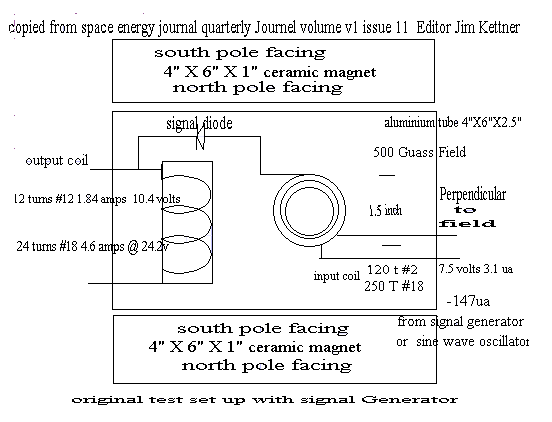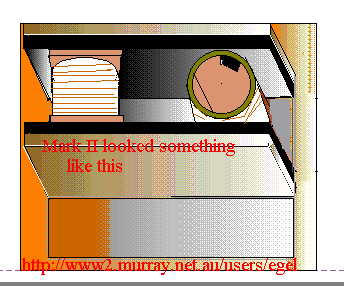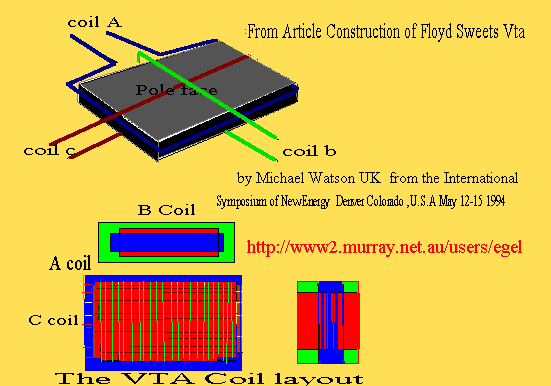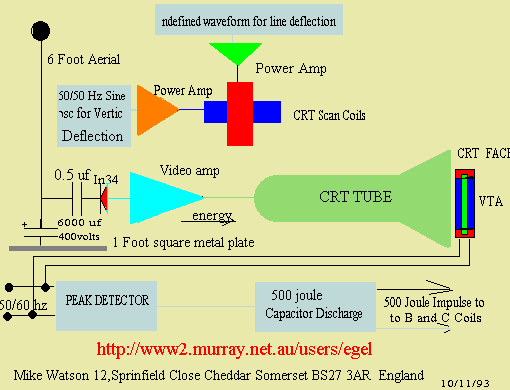
I have heard for some time about the Floyd Sweet Vacuum triode experiments of which I have seen a small
video on the internet of the device in operations but I afraid like most devices claiming overunity details appear sketchy
and often incomplete. The following likewise is no different.
The following is copied from a paper from the Space Energy Journey and as I saw no copyright information on the information , so I reproduce some of it, for the benefit of others.
The edition is the Volume VI Issue II June 1995 .Editor Jim Ketter and consultant Don Kelly
May 18 1995
The accompany data describes the Mark II V.T.A unit which is generally based on the previous VTA project of 1992/3
This present Mark II variation of the V.T.A concept is quite interesting since the input and output coils are at right angles to each other which may be a significant and useful departure from the previous designs.
Builders of the present Mark II unit must be advised that Sparky's data here may be filled with errors and flaws, and most of the specifications must be started up from scratch.
We are not quite sure why Sparky presents such Flaws in his Data releases, but they are so glaring as to defy description and make us question the value of this project work, at this point!
An example of such flaws are the input coil data, ie, 250 turns of #20 gauge (assumed) magnet wire, which make a coil length of 8 inches long.
The core material is not specified but presumed to be thin gauge iron or steel to provide a continuous magnetic field between the magnets.
When one tries to fit in this 8" long coil into the specified rectangular -- aluminium tube, we run into trouble ,and must make changes.
Obviously ,if the first modification is selected ,this 250 turn, #18 gauge wire more the core length 8" long coil which further aggregates the "aluminium shield " problem. It appears practical to build an aluminium sheet box in a rectangular form within the two magnetic plates.
The Status of this project work as of August 97 the web master has no additional information to add
(maybe some one can enlighten me) apart from that below.
One CA. researcher has built this Mark II unit and found the coil resistances to be much higher than noted, and therefore noted voltages much lower than stated.
The Mark II unit here has not yet been tested, but it is now imperative that we get to the bottom of this Mark II concepts , so we can either praise it, or throw it out, so that no further time wasted on it.

.
The Mark II device used two Barium Ferrite 6" by 4" by 1" magnets and a single input and output coil, Sparky did not indicate any mention that magnet conditioning was required.

Details from Lab notes of first successful tests
Original Test Setup
Signal generator used to drive exciter coil (Wavetek U.S.A)
Exciter coil 1.5" diameter 120 turns #20 gauge ( resistance ~1ohm)
output coil 1.5 " diameter #12 gauge.
Input 7.5 volts x 3.1u amps =23 u watts
Output 10.4 volts x 1.84 = 19.15 watts approx 400Hz
Comments
Frequency generally affected resistive 1.8 amp 200 watt bulb load proportionally- brightness increased with frequency ,decreased with frequency except at certain points when it appeared inversely related ,increasingly as frequency decreased etc.
First Modifications
The Signal generator was replaced with a purpose built Sine Wave Oscillator of nine volts output. The exciter coil was increased to 250 turns #18 gauge (1.024) and the output coil was increased to 24 turns of #8 gauge (1.024).magnets, spacing etc. all remained the same.
Input =7.2 volts by 143 uamps =.001watts
Output 24.2 volts by 4.6 amps =111watts frequency 388 and 402 Hz
Comments
by increasing the area of the wire exposed to/or occupying the fluctuating magnetic field the output was doubled. Exact proportions/ratios of the space filling volume of windings to output have not yet been determined.
Magnet size seems to be secondary to volume of the windings wire, diameter, input voltage and current.
Current limited by wire impedance only rises dramatically in the field to several hundred kohm from impedance external to the field of 2-3 @ 400 hz (250 turns #18 (1.0mm)
AC excitation current is only required to support I2R losses the magnetic field requires no power, is not loaded by wires passing through field etc.
Whole unit ran 10 -12 hours with no heating but no longer duration tests were performed.
Test were witnessed by three people.
Technical Notes.
Quality of oscillator is important- there should be no harmonic distortion ie. pure sine wave output.
Signal diode divides the current into the circuit, being parallel -puts a small microamp current into the power coil as well as the excitation coil. This works with the magnets in such a way that there is produced a vector complementation.
Bulbs vibrate in close proximity to the magnets.

In earlier units
It may be also true that previous magnetic were conditioned in s special way by have three coils wound right angles
to each other as shown in the diagram above but can not proving each way.
If the following is true it seems that there was a need to create a special bubble in the permanent magnet that was made of barium Ferrite of maybe grade 5 or grade 8 spaced 3 inches apart.
Apparently it may be difficult to obtain these type of magnets today as they have been with drawn from general manufacture.
It seems a high electrical pulse was needed in coils A and B to bring the P/magnet into this condition
After the conditioning this device was left running for several hours but power output was know to vary depending on time of day.
It seems the output coil consist of 20 gauge magnetic consisting of several hundred turns with a large resistance component. .It is assumed not confirmed that the coils are bifilar wound with current flowing in opposite directions.
The conditioning process also seems to determine the operating frequency.
One interesting side effect noticed as well with other machines is they tend to run cold suggesting this is a different type of power with the effects obtained with normal electricity.
It is also reported that 9 volts was enough to get the unit to output power.
If anyone as additional information I would like to hear about it.
I also believe the operation of this device has similarities to the Swiss ML machine.

This following text is copied from
Delivered-To: mailing list jlnlabs@egroups.com
Date: Tue, 25 Jul 2000 08:39:59 GMT
Subject: [jlnlabs] A way to programmed magnet
Hi All
A way to programmed magnet by Don Watson.
(this is only a part of the article, you will find the rest of it at:
Text from: http://216.60.190.54/comm697.htm)
Sweet VTA, ISNE and miscellany - 06/15/97
In fact, Don Watson said the magnet to be programmed was to be excited between two plates that were charged with at least 20KV (DC or AC). This would cause a 'ringing' in the barium which would last for upwards of 15 minutes.
During that time, the magnet could be subjected to a sharp pulse at roughly 260 degrees of a 60 cps sinewave. He said this was based on his own experiments and seemed to get the best results.
Why would I believe Don Watson? Because he showed me two magnets, both 4" X 6" by 1/2" thick. One was 'programmed', the other was not.
Using a piece of magnetic field line viewing plastic to view the unprogrammed magnet, I could clearly see the south pole on one face and the north pole on the other face, separated at the middle of the 1/2" magnet width by the Bloch wall.
However, in the programmed magnet, the south pole did not stop at the midpoint, but wrapped up onto the face of the north pole section, extending inward from the edge by about 1/4". That is where the Bloch wall HAD MOVED.
It was like altering the duty cycle of a square wave, where a normal magnet would be analogous to a North/South relationship of 50:50, the programmed magnet was something like 30:70. Quite amazing!
Additionally, there was a bubble within the top North pole face, looking much like an air bubble in water covered by plastic. And when you put another magnet near this bubble, IT MOVED away, just like pressing on a sheet of plastic to move the captive air bubble.
Don said the programming did not always take, but that you could just do it again, using the same magnet until it did. Also that some magnets were imperfect, having internal fractures not visible without using the magnetic viewing plastic.
The slabs were also sensitive to shock or outside stimulus which would kill the programmed effect and necessitate the magnet being reprogrammed.
Luco
Other Sites dealing with Floyd Sweet Vta
